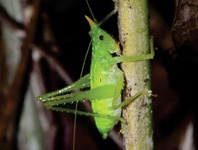Abstract
Austrotyla awishoshola n. sp. is described from the moss gardens of one lava tube cave in El Malpais National Monument, Cibola Co., New Mexico. Most chordeumatidans require mesic conditions, and these environments are limited to moss gardens in several cave entrances and beneath cave skylights in El Malpais. Presently, this species is known from the moss gardens of a single of cave in the monument. We suggest A. awishoshola may be a climatic relict, having become restricted to the cave environment following the end of the Pleistocene. We discuss the importance of cave moss gardens as refugial and relictual habitats. Recommendations are provided to aid in the conservation and management of A. awishoshola and these habitats.
References
Barr, T.C. Jr. (1968) Cave ecology and the evolution of troglobites. Evolutionary Biology, 2, 35–102.
http://dx.doi.org/10.1007/978-1-4684-8094-8_2Benedict, E.M. (1979) A new species of Apochthonius Chamberlin from Oregon (Pseudoscorpionida, Chthoniidae). Journal of Arachnology, 7, 79–83.
Cary, S.J. & Jacobi, G.Z. (2008) Zoogeographic affinities of southwestern USA Plecoptera. International Advances in the Ecology, Zoogeography, and Systematics of Mayflies and Stoneflies, 2008, 133–157.
http://dx.doi.org/10.1525/california/9780520098688.003.0011Cascadden, T.E., Kudo, A.M. & Geisman, J.W. (1997) Discovering the relationships in a family of volcanoes: Cerro Candelaria, Twin Craters, Lost Woman Crater and Lava Crater. New Mexico Bureau of Mines and Mineral Resources Bulletin, 156, 41–52.
Chamberlin, R.V. (1910) Diplopods from the western states. Annals of the Entomological Society of America, 3, 233–262.
http://dx.doi.org/10.1111/j.1096-3642.1987.tb01344.xCrawford, C.S. (1979) Desert millipedes: a rationale for their distribution. In: Camatini, M. (Ed.), Myriapod Biology, 1979, pp. 171–181.
Crawford, C.S. (1988) Nutrition and habitat selection in desert detritivores. Journal of Arid Environments, 14, 111–122.
Crawford, C.S., Berkovitz, K. & Warburg, M.R. (1987) Regional environments, life-history patterns and habitat use of spirostreptid millipedes in arid regions. Zoological Journal of the Linnean Society of London, 89, 63–88.
http://dx.doi.org/10.1111/j.1096-3642.1987.tb01344.xEriacho, W. Sr. & Chavez, V. (1998) Shiwi'ma Isamma: Bena:we - Zuni Glossary. Zuni Public District No. 89, Zuni, New Mexico, 137 pp.
Gilgado, J. D., Enghoff, H., Tinaut, A., Mauriès, J.-P. & Ortuño, V. (2015) Sierra Nevada (Grenada, Spain): a high-altitude biogeographical crossroads for millipedes (Diplopoda) with first data on its MSS fauna and description of a new species of the genus Ceratosphrys Ribaut, 1920 (Chordeumatida: Opisthocheiridae). Zootaxa, 4044 (3), 391–410.
http://dx.doi.org/10.11646/zootaxa.4044.3.4Hoffman, R.L. (1980) Classification of the Diplopoda. Muséum d’Histoire Naturelle Genève, Gèneve, 237 pp.
Howarth, F.G. (1983) Ecology of cave arthropods. Annual Review of Entomology, 28, 365–389.
http://dx.doi.org/10.1146/annurev.en.28.010183.002053Howarth, F.G. (1996) A comparison of volcanic and karstic cave communities. Proceedings of the International Symposium of Vulcanospeleology (ed. by P. Oromi): 63–68. Available from: http://vulcanospeleology.org/sym07/ISV7x10.pdf (accessed 2 February 2016)
Jeannel, R. (1943) Les Fossiles Vivants des Cavernes. Gallimard.
Laughlin, A.W. & WoldeGabriel, G. (1997) Dating the Zuni-Bandera volcanic field. New Mexico Bureau of Mines and Mineral Resources, Bulletin, 156, 25–29.
Lightfoot, D.C., Bleakly, D.L., Parmenter, R.R. & Gosz, J.R. (1994) Vegetation and Wildlife Inventory of El Malpais National Monument: Final Report. Unpublished report on file with El Malpais National Monument, Grants, NM, 57 pp.
Lindsey, A.A. (1951) Vegetation and habitats in a southwestern volcanic area. Ecological Monographs, 21, 227–253.
http://dx.doi.org/10.2307/1943559Loomis, H.F. (1943) New cave and epigean millipedes. Bulletin of the Museum of Comparative Zoology, 92, 373–410.
Northrup, D.E. & Welbourn, W.C. (1997) Life in the twilight zone—Lava tube ecology, natural history of El Malpais National Monument. New Mexico Bureau of Mines and Mineral Resources Bulletin, 156, 69–82.
Peck, S.B. (1976) The effect of cave entrances on the distribution of cave inhabiting terrestrial arthropods. International Journal of Speleology, 8, 309–321.
http://dx.doi.org/10.5038/1827-806X.8.4.1Seager, R., Ting, M., Held, I., Kushnir, Y., Lu, J., Vecchi, G., Huang, H-P., Harnik, N., Leetmaa, A., Lau, N.-C., Li, C., Velez, J. & Naik, N. (2007) Model projections of an imminent transition to a more arid climate in southwestern North America. Science, 316, 1181–1184.
http://dx.doi.org/10.1126/science.1139601Shear, W. A. (1971) The milliped family Conotylidae in North America, with a description of the new family Adritylidae (Diplopoda: Chordeumatida). Bulletin of the Museum of Comparative Zoology, 141, 107–131.
Shear, W.A. (2007) Cave millipedes of the United States. V. The genus Idagona Buckett & Gardner (Chordeumatida, Conotylidae, Idagoninae). Zootaxa, 1463, 1–12.
Shear, W.A. & Steinmann, D.B. (2013) Cave millipedes of the United States. XIII. A new, troglobiotic species of Austrotyla from Colorado (Diplopoda, Chordeumatida, Conotylidae). Zootaxa, 3745, 486–490.
Shelley, R.M. & Medrano, M.F. (2006) Nesoressa crawfordi, n. gen., n. sp., a montane island milliped in New Mexico, USA; proposal of a new tribe Nesoressini and preliminary cladogram of the lineage “Aniulina” (Julida: Parajulidae). Zootaxa, 1285, 31–50.
Wynne, J.J. (2013) Inventory, conservation and management of lava tube caves at El Malpais National Monument, New Mexico. Park Science, 30, 45–55.
Wynne, J.J., Bernard, E.C., Howarth, F.G., Sommer, S., Soto-Adames, F.N., Taiti, S., Mockford, E.L., Horrocks, M., Pakarati, L. & Pakarati-Hotus, V. (2014) Disturbance relicts in a rapidly changing world: the Rapa Nui (Easter Island) factor. BioScience, 64, 711–718.
http://dx.doi.org/10.1093/biosci/biu090

